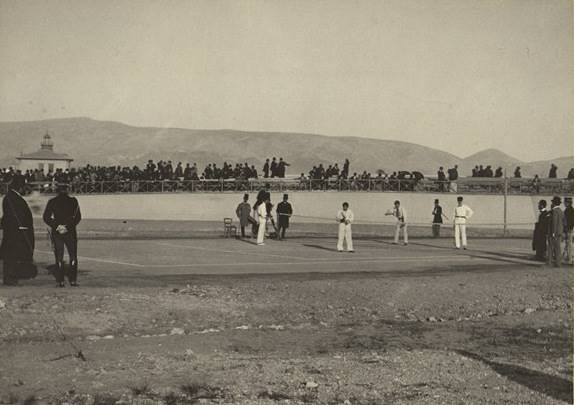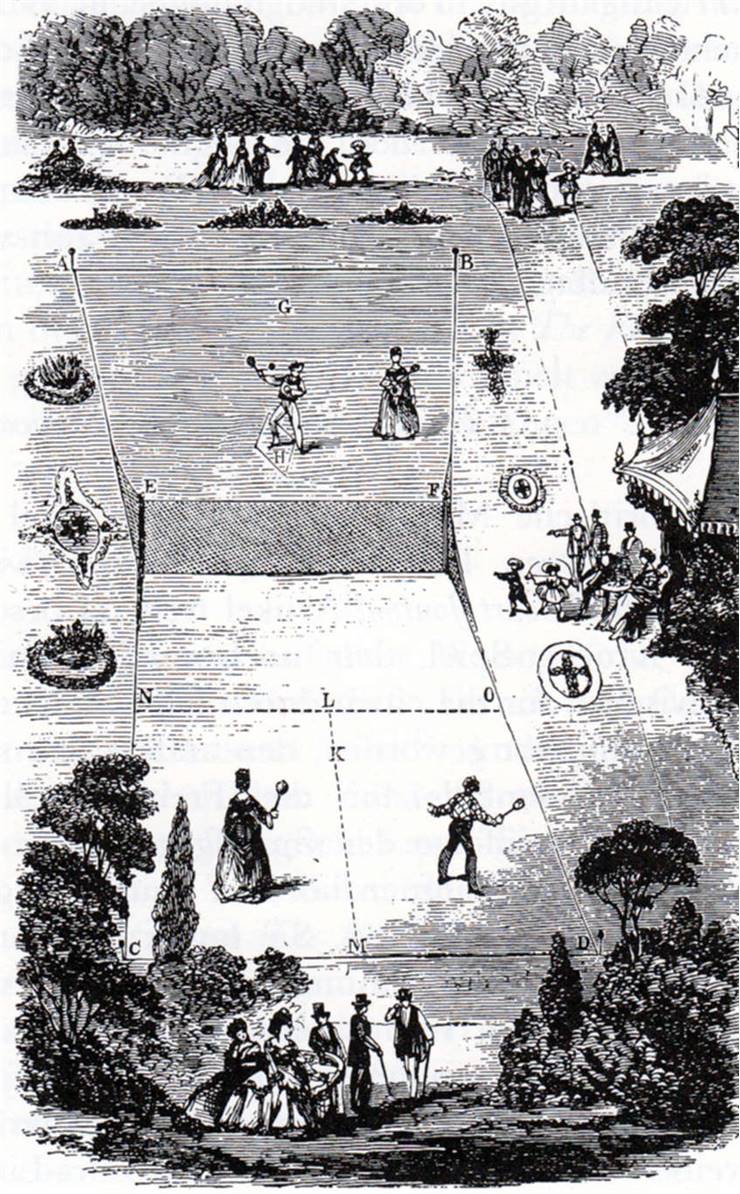History of Tennis - Origins and Evolution of Tennis
Introduction
When it was initially devised in 12th century northern France, the sport today known as tennis did not look very similar to its modern variant which is still played today. It did not use the racket, but instead, a ball was hit with the open palms of the hand. After being adopted by the royalties and nobles of France, England, and several other European territories, the “royal tennis” (known in France as “ jeu de paume” - the game of palms) transformed into a sport that much more resembled modern tennis when simple rackets were adopted in the 16th century.
As tennis became increasingly popular and newly discovered lawnmowers (patented in 1830) enabled tennis courts to move to open grass fields, professional clubs and large courts appeared across Europe and the rest of the world. The most notable courts became the foundation of the “Four Majors” tournament -Wimbledon (1877), U.S. Open (1881), French Open (1891), and Australian Open (1905). Professional tennis players established a well-known annual competition known as “Davis Cup” in 1900 and, more recently, the Fed Cup in 1963.
Between its inception and the mid-20th century, tennis maintained an image that it was one of the preferred sports of upper/middle-class players. However, that image started wavering when commercial pressures opened major tennis tournaments to professional and amateur players.
Etymology
The modern word tennis was derived from the French word “ tenez,” which is a plural imperative form of the verb tenir ("hold!", " receive!" or "take!"). This term was used as a call from the server to his opponent, indicating that he was preparing to serve the ball across the court.
The " racket " was derived from the Arabic word “rakhat,” which translates to the “ palm of the hand.”
Predecessors of Tennis
Some historians believe that the origins of Tennis could be found much earlier than is today accepted.
Clues found in the ruins of Egyptian, Greek, and Roman civilizations (including written reports in Arabic) point that a game similar to tennis was played on stone floors and dirt fields. Another theory says that the word tennis was derived from the Egyptian town of Tennis or Tinnīs. However, the lack of concrete evidence has pushed the majority of historians to accept that one true predecessor of modern tennis was created in 12th-century Italy.
Jeu de paume
Jeu de paume is a precursor of modern tennis. Originally devised by Italian priests and played extensively by common people in northern Italy, this “ palm game” involved smacking balls in indoor courts without rackets.
Palm game managed to achieve notable recognition. It could be played indoors and outdoors, and in 1908 it even became part of the Summer Olympics, in which American Jay Gould II won the Gold medal against Eustace Miles from Great Britain. Today, Jeu de paume is regarded as the longest ongoing annual world championship in the sport, with over 250 years of uninterrupted competition.
Real Tennis
While Jeu de paume was sometimes also called “ real tennis,” this distinction is today closely connected to the variation of palm tennis in which players used rackets to smack the ball across the playing field. Evolving throughout the 16th to mid-19th century, real tennis moved towards racket play and became extremely popular in the royal courts of Europe. Royalty played real tennis so much that this sport was directly connected with the deaths of King James I of Scotland (assassin), Louis X (exhaustion and severe chill), and Charles VIII (head injury).
The sport's popularity in France led King Charles IX to establish the Corporation of Tennis Professionals in 1571, with three professional leagues consisting of apprentice, associate, and master-level players. The first written rules of this real tennis league were published in 1599.
During the 17th and the first half of the 18th century, tennis expanded in popularity across Europe, except in two territories - England, where Puritanism did not approve of such activity, and France, where nobility came under pressure from dissatisfied commoners.
18th-century England slowly moved away from real tennis and more toward lawn tennis, which eventually became what we know as modern tennis.
Lawn Tennis Beginnings
The origins of lawn tennis can be found in the exploits of Birmingham, England, Major Harry Gem, who managed between 1859 and 1865 to combine the elements of rackets successfully, Spanish ball game "plota," and croquet lawn playing field. He and his friends formed the first modern tennis club in 1874, Leamington Tennis Club.
During just one to two years, many aspects of modern tennis were standardized with the efforts of British army officer Walter Clopton Wingfield. He devised basic rules, an hourglass-shaped playing field, and more. During that time, tennis also fueled the establishment of several more cubs and organized competitions.
Lawn tennis (sometimes also called “ Wingfield’s game”) arrived in the United States just a few years later, in 1877.
Walter Clopton Wingfield Biography
Major Walter Clopton Wingfield (1833-1912) was a famous welsh inventor that is remembered today as the father of lawn tennis and a crucial figure in forming the style of modern tennis that is played today.
After military campaigns in India and China and earning a rank of Major, Wingfield returned home to England, where he eventually became appointed to the Honourable Corps of Gentlemen at Arms, overseeing the courts of the royal family (Queen Victoria and her son Edward VII). During that time, he started experimenting with lawn sports, and most notably, trying to see if newly developed rubberized balls that could bounce much better than the widely used ones could be integrated into the indoor game of real tennis.
To transfer this indoor sport to the flat surface of croquet lawns, he eventually patented “ New and Improved Court for Playing the Ancient Game of Tennis,” which he started promoting under the name of “Sphairistikè” in the spring of 1874. He sold boxes of rubber balls at several courts and played exhibition matches in which the main net that separated two players was set at 4 feet 8 inches high. A scoring system awarded each player 15 points for a successful “ace.” He sold over 1000 ball sets to the English aristocracy in just a year, pushing many croquet lawn owners to adapt them into tennis courts.
After just a few years of successfully promoting a game, Wingfield lost interest in tennis after his wife developed mental illness and his three young sons died.
First Tournaments - The Championships, Wimbledon - 1877
The famous Wimbledon courts were established in 1868 as a private club that provided lawns and courts for aristocratic players who enjoyed croquet. However, with the rise of the popularity of Major Walter Clopton Wingfield's “lawn” version of real indoor tennis, this private club switched its focus to tennis by renaming itself "The All England Croquet and Lawn Tennis Club" and starting annual tournaments starting with the famous inaugural 1877 Wimbledon Championship.
This influential tournament was not important only because of the tradition it would set but also because of the modified rules that it would use. Wimbledon tournament officials devised a rule set that became a basis of modern tennis, with the only differences being the distance of the service line, the width of the net posts, and the height of the net itself. In 1922 Wimbledon courts moved to a new position, but the playing field's overall position remained the same, including the famous “center court” surrounded by smaller tennis courts.
In addition to men's singles matches Wimbledon started promoting Ladies' Singles and Gentlemen's Doubles competitions in 1884 and Mixed Doubles events from 1913. Up to 1968, Wimbledon tournaments were filled with only top-ranked amateur players, but that changed with the adoption of the “open era” that allowed professionals to compete also.
Today, Wimbledon is considered to be the world's premier tennis tournament in the world.
The Davis Cup
The famous Davis Cup tennis tournament was originally devised in 1899 by four Harvard University tennis team members who wished to test the capabilities of British players. By the time the first official Davis Cup match in 1900 pitted Britain and the United States, this tournament had already gained popularity. Several years later, the Davis cup attracted national teams from several more European teams, with Australia and New Zealand joining in 1914.
From that point on, the tournament gained worldwide recognition, spitting into several sections (Eastern, American, and two European zones) to better handle the increasing number of national teams, the format of competition switched to knockout elimination in 1972, and its modern tiered system of competition that is still in use today was devised in 1981. In it, teams from 12 sub-groups compete each year for the chance to enter into the main “World Group,” which consists of teams from 16 best-ranked countries.
In 2017, Argentina, France, and Great Britain were the best-ranked national teams in Davis Cup.
History of Tennis Courts
Grass Court History
Neatly trimmed short grass on top of a very hard packed soil layer is the most popular tennis surface type, but sadly they are not the most commonly found one today. High maintenance and time commitment needed to keep them in top shape has pushed many courts to switch to clay or other types of surfaces.
Grass offers the fastest movement, but the differences in grass density determine how the ball will bounce off. Negative points of grass courts are that they have to be regularly trimmed and kept in good condition without the appearance of wear and tear after prolonged plays.
Since the bounces of the grass are low, this surface usually leads to faster and more energetic plays that are best suited to the players who favor the serve-and-volley type of play.
Clay Court History
Clay is the most popular tennis court surface in Europe and Latin America. Since clay reduces the speed of the ball after bounces, this surface heavily disadvantages fast servers and promotes baseline players .
Clay courts have been proven to be easy to initially create, but they require significant costs for upkeep and keeping the top surface nicely even and properly dry. Out of all Majors, only French Open uses this court surface type.
Hard Court History
The surface of hard courts is made from a rigid and uniform material that is commonly coated with an additional acrylic surface layer that is sometimes mixed with sand. The amount of sand determines how fast will ball bounces be. This surface type slows down ball bounces a bit, somewhere in between the speed of grass and clay courts.
Different types of hard surfaces are used for both US Open and Australian Open.
Carpet Court History
“Carpet surface” in tennis represents any surface that can be removed or reinstated at moment’s notice. Many indoor arenas use rolls of rubber-backed court surfacing to easily convert themselves for tennis tournaments that are played on artificial turf. This surface type is very common in Asia, and some of the big tournaments (such as Paris Masters, WCT Finals, and others) are also played on top of it.

